Cervical Spondylosis - How Can It Be Treated?
As you age, many parts of the body start to wear down. Your spine is no different in this regard. When age affects the condition of the cervical section of the spine, it is known as cervical spondylosis. Other names for the disorder are neck arthritis or cervical osteoarthritis.
Even though age causes most cervical spondylosis, other factors may also be responsible for the onset of the disorder. Here is a look at some common causes for the same.
Causes for cervical spondylosis:
• Bone spurs - Your body may try to strengthen the joints by growing additional bone tissues. These are known as bone spurs. These spurs can pinch down on the nerves and the spinal cord, leading to pain and other symptoms.
• Dehydrated discs - The spine houses shock-absorbing pad-like structures between the vertebrae, called discs. These discs contain a gel-like substance that gives them its unique shock absorbing properties. Over time, the gel dries out, causing greater friction between bones during movement.
• Injury - A neck injury can lead to cervical spondylosis. The disorder may not appear as soon as you suffer from the injury but may take years to develop.
• Excessive physical strain - Some profession may require people to lift heavy weights or overexert themselves physically. These people may develop cervical spondylosis later on because of this work.
Symptoms of cervical spondylosis:
Here are some symptoms that are commonly associated with cervical spondylosis.
• Shoulder pain - Patients suffering from cervical spondylosis often complain about pain in the shoulder blade. This pain increases while the person is standing, sitting, coughing, sneezing and tilting their head backwards.
• Weakness - People with cervical spondylosis also suffer from muscle weakness. For instance, you may not be able to grab things tightly in your hands, if you suffer from the spinal disorder. Furthermore, lifting the arms may be difficult.
Other minor symptoms of cervical spondylosis include stiffness in the neck that grows worse with time and headache that affects the back part of the head.
Treatment for cervical spondylosis:
Treatment is not necessary in many cases due to the absence of any distinguishing symptoms. However, if the spondylosis interferes with normal life, medical intervention is required. Treatment for the disease includes-
• Physical therapy - Physical therapy sessions often help deal with the pain and stiffness resulting from the cervical spondylosis. Your doctor will prescribe weekly sessions, which will aid to reduce the symptoms of the condition after some time.
• Medications - Pain medications help manage the discomfort related to the condition. However, these drugs do not have any long-term effect on the body. They only provide temporary relief from the pain.
• Surgery - Surgery for cervical spondylosis is uncommon. However, if the condition does not respond to other forms of treatment, the operation may be required to remove bone spurs, herniated discs and rectify parts of the spinal column.
You can also ask your doctor about home remedies to follow to manage the symptoms of the disease.



+1.svg)
